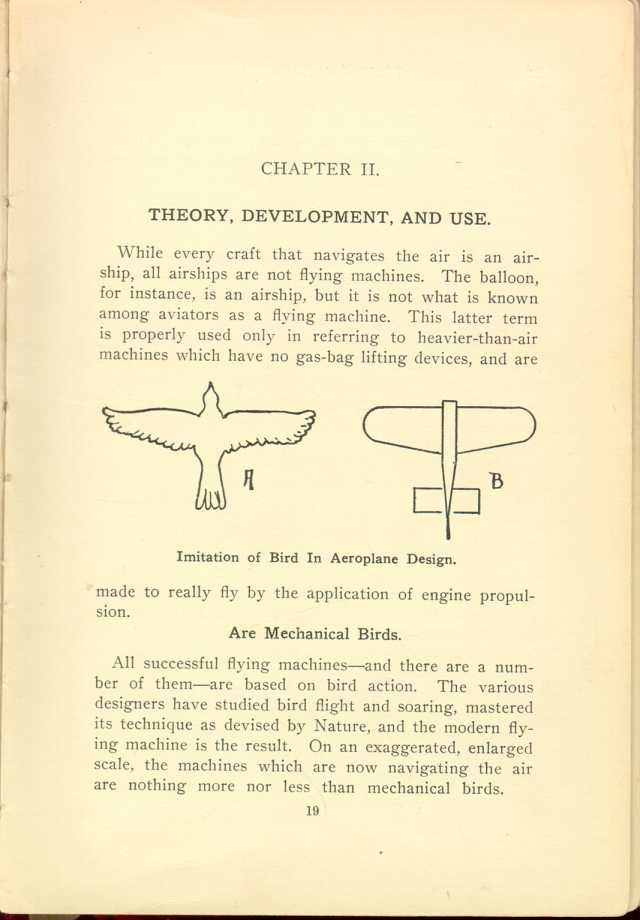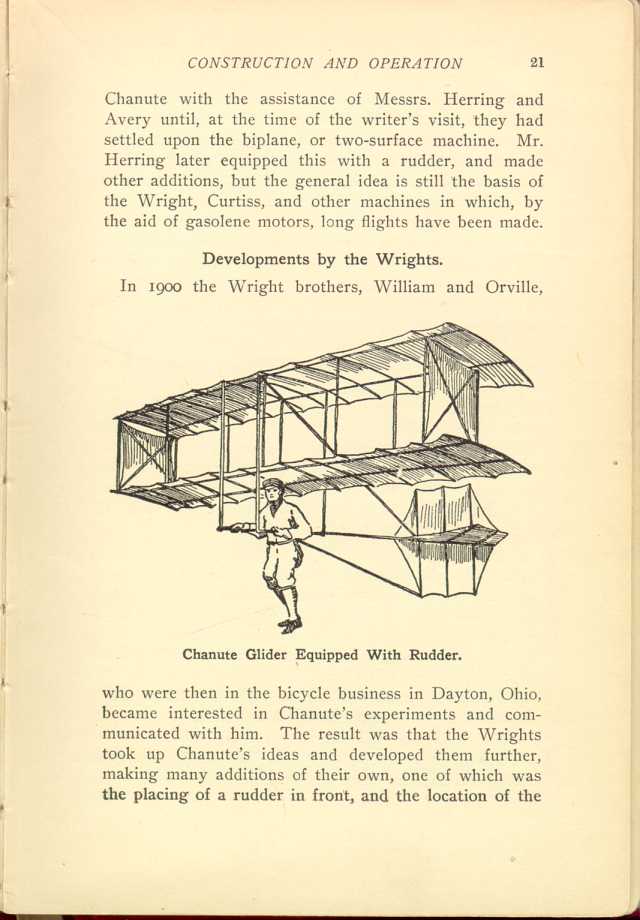2. CHAPTER II.
THEORY, DEVELOPMENT, AND USE.
While every craft that navigates the air is an airship, all airships
are not flying machines. The balloon, for instance, is an airship, but
it is not what is known among aviators as a flying machine. This latter
term is properly used only in referring to heavier-than-air machines
which have no gas-bag lifting devices, and are

Imitation of Bird In Aeroplane Design.
[Description: Black and white illustration: One the left, a view of a bird's
wingspan as from above; on right, a view of an aeroplane as from above.]
Are Mechanical Birds.
All successful flying machines—and there are a number of them—are based on bird action. The various designers have studied bird flight and soaring, mastered its technique as devised by Nature, and the modern flying machine is the result. On an exaggerated, enlarged scale the machines which are now navigating the air are nothing more nor less than mechanical birds.
Origin of the Aeroplane.
Octave Chanute, of Chicago, may well be called "the developer of the flying machine." Leaving balloons and various forms of gas-bags out of consideration, other experimenters, notably Langley and Lilienthal, antedated him in attempting the navigation of the air on aeroplanes, or flying machines, but none of them were wholly successful, and it remained for Chanute to demonstrate the practicability of what was then called the gliding machine. This term was adopted because the apparatus was, as the name implies, simply a gliding machine, being without motor propulsion, and intended solely to solve the problem of the best form of construction. The biplane, used by Chanute in 1896, is still the basis of most successful flying machines, the only radical difference being that motors, rudders, etc., have been added.
Character of Chanute's Experiments.
It was the privilege of the author of this book to be Mr. Chanute's guest at Millers, Indiana, in 1896, when, in collaboration with Messrs. Herring and Avery, he was conducting the series of experiments which have since made possible the construction of the modern flying machine which such successful aviators as the Wright brothers and others are now using. It was a wild country, much frequented by eagles, hawks, and similar birds. The enthusiastic trio, Chanute, Herring and Avery, would watch for hours the evolutions of some big bird in the air, agreeing in the end on the verdict, "When we master the principle of that bird's soaring without wing action, we will have come close to solving the problem of the flying machine."
Aeroplanes of various forms were constructed by Mr.
Developments by the Wrights.
In 1900 the Wright brothers, William and Orville,

Chanute Glider Equipped With Rudder.
[Description: Black and white illustration: Man in a glider with two-surface
wing and a large rudder.]
Limits of the Flying Machine.
In the opinion of competent experts it is idle to look for a commercial future for the flying machine. There is, and always will be, a limit to its carrying capacity which will prohibit its employment for passenger or freight purposes in a wholesale or general way. There are some, of course, who will argue that because a machine will carry two people another may be constructed that will carry a dozen, but those who make this contention do not understand the theory of weight sustentation in the air; or that the greater the load the greater must be the lifting power (motors and plane surface), and that there is a limit to these—as will be explained later on—beyond which the aviator cannot go.
Some Practical Uses.
At the same time there are fields in which the flying machine may be used to great advantage. These are:
Sports—Flying machine races or flights will always be popular by reason of the element of danger. It is a strange, but nevertheless a true proposition, that it is this element which adds zest to all sporting events.
Scientific—For exploration of otherwise inaccessible regions such as deserts, mountain tops, etc.
Reconnoitering—In time of war flying machines may be used to advantage to spy out an enemy's encampment, ascertain its defenses, etc.